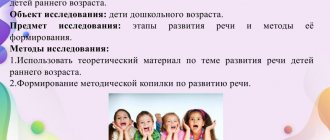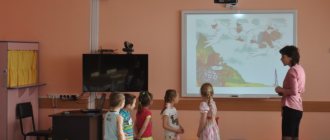Romanova Vitalina Anatolyevna, teacher of MBDOU kindergarten No. 10 “Lazorik” in the city of Donetsk, Rostov region
Introspection
experimental activities with children of the second younger group
"Introduction to the properties of water"
The educational activity was carried out during the time allotted in the daily routine, 7 children were present. The children of the group have developed skills in educational activities, they easily make contact with the teacher. They know how to hear and listen to the teacher. The educational activity was carried out in accordance with the outline, in drawing up which, I first of all took into account the age, psychological and individual characteristics of the children, outlined the goal, objectives, and content of the educational activity, determined the form of implementation, methods and techniques necessary to obtain positive results. OOD was built in the form of experimental research activities for children, which contains the integration of educational areas: “Speech development”, “Cognitive development”, “Social and communicative”.
The purpose of educational activities is to activate mental abilities, logical thinking, creativity of children, and the ability to draw conclusions.
Tasks:
Educational: develop dialogical, monologue speech of children, enrich vocabulary with words denoting the properties of water.
Developmental: to promote the development of children's cognitive activity, curiosity, desire for independent knowledge and reflection.
The logic of constructing the OOD allowed it to be carried out within the allotted time. The duration of the OOD is 15 minutes, which corresponds to the standards of SAN PiN.
Analyzing the children’s activities, I would like to note that they showed cognitive activity throughout the entire time and reacted emotionally to methods of activating activities. They were interested, attentive, organized, felt comfortable, and were relaxed. The questions (tasks) offered to the children, to which they themselves found the answer, drew appropriate conclusions, encouraged the children to take action and solve the assigned problems. I believe that the chosen form of organizing the OOD was quite effective, which made it possible to see the final result in specific activities. The effectiveness of OOD was also facilitated by preliminary work (children used existing knowledge and skills) carried out in the group, namely: constant observations of rain and snow during walks at different times of the year, observation of how evaporation occurs after rain in active sunlight, conducting experiments with water, snow, ice, looking at snowflakes, decorating ice buildings with colored pieces of ice, reading fiction, solving riddles, using folk signs in practice, etc. The interconnection and interdependence of OOD elements and the implementation of practical tasks helped create a positive emotional background of the activity process and maintain interest throughout the entire time. The proposed tasks were accessible in complexity to the children, which contributed to the solution of the assigned tasks, the children felt like “creators”, were happy, surprised, admired, willingly shared their discoveries with the teacher and their friends, and this made it possible to develop their positive self-esteem and self-worth: “U I succeeded!”, “I know,” etc. The children were friendly, responsive, and helped each other. At every moment of educational activities, I tried (while being nearby) to quietly guide the children to find a problem, helped them gain new experience, the specifics of working with children were reflected in a person-oriented, differentiated approach to learning, expressed in the performance of tasks of different levels of complexity, taking into account the level of knowledge and “ zone of proximal development" of each child. Individualization of training was manifested in providing assistance, reminders, and additional explanations to those who had difficulty performing experiments. The children were constantly praised and encouraged in order to consolidate their situation of success. Changing activities (experiments, experimenting, guessing riddles, reading poetry, dynamic pause) helped prevent fatigue. The manuals were of sufficient size, bright, colorful, and selected at a level accessible to children. She used visual, verbal and practical methods that were aimed at using cognitive, speech, motor skills and abilities, improving them, and developing attention, imagination, memory, speech. The children were pleased with the fact that they constantly showed curiosity, were interested in cause-and-effect relationships, tried to independently come up with explanations, and were able to observe and experiment. They have basic knowledge about the natural and social world, are capable of making their own decisions, and are prone to volitional efforts. They have a fairly good command of oral speech and can express their thoughts and desires using speech. The program tasks were solved, OOD achieved its goal.
Self-analysis of the lesson “Properties of water - colorlessness” in the first junior group of a preschool educational institution
- June 19, 2019
International and All-Russian competitions
Laureate of the All-Russian competition of pedagogical excellence “Methodological piggy bank of a kindergarten teacher”
Lesson “Child and the world around us.” Conducted by teacher Yavorskaya E.Yu., MBDOU General Development Kindergarten “Golden Key”, Zheleznogorsk-Ilimsky, Irkutsk Region.
Type of children's activity/cultural practice - experimenting with materials and substances (types of children's activities for children under 3 years old).
Number of children – 8 (subgroup).
The duration of the lesson is 10 minutes.
Integration of educational areas – “Artistic and aesthetic development” and “Cognitive development”, priority direction – “Cognitive development” (experience in coloring water).
Methods and techniques:
- verbal (reading a nursery rhyme while washing hands, asking children “What color is the water?”, conversation)
- practical (painting balls, coloring water)
- visual (looking at water, balloons, drawings, etc.)
It was very important for me to bring the children to understand that water has no color (colorless), Vanya M. said that the water is white, and I showed the children a white sheet of paper and a glass of water so that they could see the difference.
Another important point was not to give children an incorrect scientific understanding of the properties of water and not to confuse the property “colorlessness” and the property “transparency ,” which we later became acquainted with during a didactic game.
coloring balloons along the finished contour to enrich the educational effect of the lesson and increase cognitive activity (at the end of the lesson, the children chose a balloon of the same color as the one they were drawing, that is, they compared three objects (a drawn balloon, water in a glass and a balloon) by color , used the words “the same, the same”) in speech.
In order to increase the children’s speech activity, I asked questions not to the whole group, but to specific children (“Faya, what color is the water in your glass? What about you, Misha?”, “What is drawn on the paper, Olya? What color is the ball?” ).
Directly during the water coloring experiment, emotionally to the result (“Oh, look how the water has become!”). Faya Sh. painted the water with red paint and reacted very emotionally: “Pink!” Since not all children know the name of this color, I suggested that Faye add more paint to the water so that the color of the water approaches red.
While drawing, I watched how the children sat at the table , how they held brushes, picked up paint, and painted the ball from top to bottom.
After coloring the water, I organized a discussion to consolidate the lesson , and for this purpose I invited the children to leave the table.
the surprise moment , although some had difficulty remembering what color they were working with; they went to the table, found their drawings and cups of water, returned and chose a ball of that color.
The goal and tasks set by me were completed in full, and after the lesson, the children, when asked what color the water was, answered that it had no color. In the evening they told their parents how they “painted” the water red, blue, green and yellow.
The emotional background of the lesson was very friendly, the children talked a lot, willingly answered questions, rejoiced at the changing color of the water and the balloons, played with them with pleasure, repeating the names of the flowers.
The development was presented by Tatyana Vasilievna Gaar
Self-analysis of the final GCD in the second junior group “Journey to the magical land of mathematics”
Tatyana Korochkova
Self-analysis of the final GCD in the second junior group “Journey to the magical land of mathematics”
Self-analysis of the final lesson in the second junior group No. 11.
Topic: “ Journey to the magical land of mathematics ”
Date: 05/18/2021
Number of children: 16
Educator: Korochkova Tatyana Yakovlevna
The lesson was carried out in accordance with the notes. The abstract was compiled independently , in accordance with the objectives of the basic general education program, corresponding to the given age of the children. Form of organization: frontal, individual
Goal: To identify the level of acquired knowledge of elementary mathematical concepts .
Educational:
- Improve the ability to distinguish and name geometric shapes (circle, square, triangle, three-dimensional figures - ball and cube;
— Strengthen the ability to compare objects by color (same - different, quantity (one, many, none), size (large-small)
and indicate the comparison results with appropriate words;
— Improve the ability to single out one item from a group .
Educational:
- develop the ability to distinguish and name primary colors;
- develop thinking: learn to see in a drawing what figures it consists of;
Educational:
- cultivate interest in mathematics , independence ;
- cultivate dedication, the ability to complete the work started.
To implement each task, techniques were selected to help solve software problems entertaining For each moment of the lesson, visual aids were selected that stimulated and activated children’s mental activity. The manuals are of sufficient size and aesthetically designed. Their placement and use was rational, well thought out in the learning space . During the lesson, children were offered a variety of activities: cognitive, social-communicative, productive, gaming. Lesson structure: consists of three parts, all of them are interconnected by one theme.
2 of the children did not fully master the material .
In the future, individual work with these children is planned.
The duration of the lesson complies with hygiene standards for young children - 15 minutes . Air, heat and sanitary conditions were observed.
The lesson is dynamic, it includes techniques that provide for a quick change of activity. Guessing riddles while sitting on chairs, an outdoor game. I believe that the program tasks set during the lesson were solved. In the final part of the NOD, they decided to give sunshine to the inhabitants of a magical land , and paid attention to the sunshine of each child.
When analyzing the GCD, we discussed with the children what geometric shapes you met, how many flowers and butterflies there were in the meadow, what we gave to the residents of the magical land , and whether you liked the trip .




